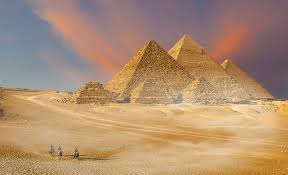The Egyptian pyramids have long fascinated historians, archaeologists, and curious minds around the world. These monumental structures, built thousands of years ago, continue to baffle modern experts with their architectural precision, engineering ingenuity, and mysterious purposes. How did ancient Egyptians manage to construct these colossal edifices without the technology we rely on today? And what secrets might still be hidden within their stone walls? Let’s embark on a journey to unravel the mysteries surrounding the pyramids of Egypt.
The Historical Context of the Pyramids

The Origins of Pyramid Building
The story of pyramid construction dates back to ancient Egypt’s Old Kingdom (c. 2686–2181 BCE). These structures evolved from earlier mastabas flat-roofed rectangular tombs made of mudbrick. Over time, architects refined their designs, culminating in the awe-inspiring pyramids we recognize today.
Why Were Pyramids Built?
Contrary to popular belief, pyramids weren’t just tombs. They were monumental expressions of power, spirituality, and the Egyptians’ connection to the divine. Pharaohs believed pyramids served as stairways to the heavens, ensuring their ascension to join the gods.
The Pyramids as Cultural Icons
These structures were more than just burial sites. They symbolized Egypt’s technological advancements and social organization. The ability to marshal resources, labor, and materials on such a scale showcased the power of the state.
Construction Techniques: How Did They Do It?
The Mystery of Moving Massive Stones
The Great Pyramid of Giza, composed of approximately 2.3 million blocks, poses a significant challenge to modern understanding. Each stone weighs an average of 2.5 tons, with some as heavy as 80 tons. How were these massive blocks transported?
Sledges and Lubrication
One widely accepted theory suggests workers used sledges to drag stones across the desert. Recent discoveries indicate that water was poured onto the sand to reduce friction, allowing the sledges to glide more easily.
Rolling Stones?
Another hypothesis proposes the use of wooden rollers. However, the uneven terrain and the sheer weight of the blocks make this idea less feasible for the entire construction process.
The Role of Ramps
Straight Ramps
Some theories suggest massive straight ramps were built to haul stones to the desired height. While plausible, the sheer size such ramps would require has led some experts to question their practicality.
Spiral Ramps
An alternative idea is that spiral ramps encircled the pyramid as it rose. This design would have reduced the space needed but might have limited access for workers.
Workforce and Organization
Laborers or Slaves?
Contrary to long-standing myths, evidence suggests the pyramids were built by skilled laborers, not slaves. These workers lived in nearby villages and were provided with food, shelter, and medical care.
Specialized Teams
The workforce was divided into teams responsible for specific tasks quarrying, transporting, and placing stones. This division of labor ensured efficiency and precision.
Architectural Marvels: Precision Beyond Belief
Aligning with the Stars
The Great Pyramid of Giza is aligned almost perfectly with the cardinal points of the compass. How ancient builders achieved such precision remains a mystery, though it’s believed they used the stars as guides.
The Golden Ratio
Some researchers argue that the pyramids incorporate the golden ratio, a mathematical principle associated with aesthetic perfection. Whether this was intentional or coincidental is still debated.
Internal Chambers and Passageways
Hidden Rooms
The pyramids aren’t just solid masses of stone; they contain intricate networks of chambers and passageways. Recent discoveries, aided by advanced scanning technologies, suggest the existence of yet to be explored rooms.
Air Shafts or Spiritual Pathways?
The so-called air shafts in the Great Pyramid were long thought to serve practical purposes. However, some theories propose they were spiritual pathways, aligning with celestial bodies.
Mysteries That Defy Explanation
The Curse of the Pharaohs
Legends of curses surrounding the pyramids add an aura of mystique. While likely exaggerated, these stories reflect humanity’s enduring fascination with the unknown.
Energy Theories
Some fringe theories claim the pyramids were more than tombs; they were ancient power plants harnessing natural energy. While there’s no scientific evidence to support this, the idea captures the imagination.
The Builders’ Knowledge
Lost Technologies
Did the ancient Egyptians possess knowledge or tools that have since been lost to history? The precision and scale of their work suggest advanced understanding of engineering principles.
Influence of Extraterrestrials?
The idea that aliens assisted in building the pyramids is a popular but unsubstantiated theory. While intriguing, it undermines the ingenuity and capability of the ancient Egyptians.
Modern Discoveries and Innovations
High-Tech Tools Unveiling Secrets
Advancements in technology, such as ground penetrating radar and 3D mapping, are helping researchers uncover new information about the pyramids. These tools have revealed hidden chambers and insights into construction methods.
Lessons for Modern Engineers
The pyramids continue to inspire architects and engineers. Their durability and design offer lessons in stability, resource management, and innovation.
The Legacy of the Pyramids
Cultural Impact
The pyramids have influenced art, literature, and architecture worldwide. They remain enduring symbols of human achievement and the mysteries of the past.
Tourism and Preservation
Today, the pyramids are among the most visited tourist sites globally. Efforts to preserve them face challenges from environmental factors and human activity.
Conclusion
The Egyptian pyramids stand as timeless monuments to human ingenuity and ambition. Despite centuries of study, they continue to guard many of their secrets. As we develop new technologies and theories, we inch closer to understanding these ancient marvels. But perhaps their greatest allure lies in the mystery itself a reminder of the boundless curiosity that defines us.
FAQs
1. How were the Egyptian pyramids built without modern technology?
The pyramids were constructed using ingenious methods such as sledges, ramps, and precise labor organization. Recent discoveries suggest water lubrication and advanced planning played crucial roles.
2. What was the purpose of the Egyptian pyramids?
Pyramids served as tombs for pharaohs and symbols of their divine authority. They also reflected ancient Egyptians’ beliefs about the afterlife and their connection to the cosmos.
3. Are there still undiscovered chambers in the pyramids?
Yes, modern scanning technologies have revealed possible hidden chambers within the Great Pyramid of Giza, which researchers are still exploring.
4. Were the pyramids built by slaves?
Evidence suggests that skilled laborers, not slaves, built the pyramids. These workers were well-fed, housed, and organized into specialized teams.
5. What mysteries remain about the pyramids?
Unanswered questions include how their precise alignments were achieved, the full purpose of internal chambers, and the methods used to transport massive stone blocks.


